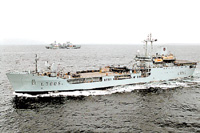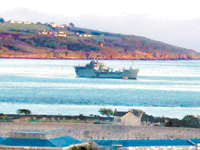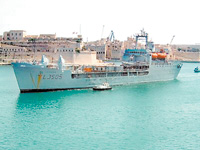 |
|||||||
| |
|||||||
|
Will millionaires become billionaires?
Huge
arms procurement missions without a proper national plan or strategy The previous United National Front (UNF) Government, which was responsible for the Ceasefire Agreement of February 22, 2002, called a halt to military procurements. So much so, there were times when security forces faced shortages of ammunition. Stocks with them dwindled due to continuing training activity. At least on one occasion, neighbouring India came to Sri Lanka's assistance by loaning a quantity. This was until stocks were replenished. The UNF's stated policy was to divert savings accruing from military expenditure for development activity. It even led to complaints that the basic needs were not met. This included uniforms, boots and camouflage T-shirts. Those who had worn out ones had no replacements. In November 2003, with the UNF still in power, President Chandrika Bandaranaike Kumaratunga took over the defence portfolio from then Minister, Tilak Marapana. This was together with the Interior and Communications ministries. It was on the grounds that national security interests were deteriorating. Yet, there was no dramatic change or drastic measures to arrest this deteriorating trend. The policies set in motion by the UNF continued. One was the move to induct troops for UN peacekeeping operations. Two soldiers have died and four were injured in the first ever assignment in Haiti. Troops there have directed repeated e-mail messages and letters to military hierarchy, political leaders and the media about delays in payments, corrupt practices and fraudulent activity. A battalion from the Sri Lanka Light Infantry (SLLI) will complete its tour of duty next month. A battalion from the Sinha Regiment is now preparing to replace them. Though the main aim of this exercise is to earn foreign exchange through the troops, it has cost the Government over a billion rupees for it. That is to meet the logistics requirements including combat vehicles, weapons, trucks, kitchenware etc. Another is the policy to allow deserters to opt out of service. Fears of troop shortages prompted the former People's Alliance Government to arrest deserters, punish them and re-induct them into service. Periodically they were also granted amnesties. The UNF did away with this practice and allowed the soldiers to opt out of service without the stigma of being officially branded as a deserter. And now, the UPFA, which complained of a deterioration of national security, continues vigorously with this policy. Other than leadership changes, no major plans to ensure greater military preparedness was put into effect. Nor were measures formulated to deal with specific issues that constituted a serious threat to national security that was deteriorating. The former UNF Government's policy of inducting Sri Lankan troops for UN peacekeeping operations and paving the way for deserters to opt out was borne out of a policy to down size the military. It stemmed from the mistaken notion that a "no war" situation had led to permanent peace. During the near two decades of the separatist war, one of the chief reasons, if not the main one, attributed by military commanders for defeats and debacles was the lack of adequate strength. In the recent weeks, this was again attributed as the main reason why the military has not been able to curb the mounting violence in the East where Tiger guerrillas are battling rival groups. This was even after an additional battalion was sent into augment troop strength in the Batticaloa district. Recent times have seen a curious exception - some former Bantam weights who gave this as the reason for many a defeat and debacle have changed positions after turning Heavyweights. A three-year ceasefire or a clear study of future threat perceptions notwithstanding, they have turned out to be the modern day Sun Tzus and Carl von Clausewitzes though their theories are brand new and self made. They want to take a possible new war with Tiger guerrillas to greater heights by going high tech. To the Sri Lankan taxpayers, this simply means a much higher cost. More so at a time when much needed foreign exchange for tsunami recovery is prompting a Government to go ahead with the controversial Joint Mechanism with Tiger guerrillas to share aid equitably. Such revolutionary changes in the defence policies of successive Governments have become possible, from time to time, only because there has been no national plan or national strategy. Hence military men, bureaucrats, non military and non bureaucrats or military men turned bureaucrats of all hues have devised their own panacea for the ills of the defence and security establishment - from running the military to winning wars. Politicians have also had a sizeable role. The objectives of some are to accomplish what they failed to do in earlier positions. A wider mass of military men who fought a war and profited by their experience have been largely ignored. So is expert advice, sometimes foreign and given in the form of voluminous reports. That it continues to happen over the years, despite a near two decades of warring, is bad enough. Worse is the fact that changing ground realities continue to be ignored. In the past three years of ceasefire, Tiger guerrillas have no doubt enhanced their military capability. They have increased their strength, acquired more state of the art weaponry and developed a new strike capability particularly outside the theatres they dominate. This is by establishing cells with weapons/suicide cadres, positioning pistol groups and intelligence sleuths in the Greater Colombo area. This came about soon after the ceasefire when checkpoints were dismantled making it easy to move weapons illicitly. They have carried out abductions with impunity. They have acquired an air capability during the ceasefire by constructing a new 1.2 kilometre long runway near the Iranamadu tank in Kilinochchi and are known to have procured two light aircraft. After the controversial Prevention of Terrorism Act was not enforced, free movement of guerrilla cadres, particularly in the city, led to the killings of intelligence operatives and informants. How much of these factors have been taken into consideration in the preparation of responses? Have they been dovetailed into a national plan or national strategy? Why is there no centralised organisation that could be responsible for all military procurements, like for example in Bangladesh? Such a unified organisation could well have ensured standardisation of equipment and thus maximised usage. Is such a plan or strategy going to be based now on hi-tech measures with a downsized military? Or would such measures be sufficient to ensure national security and public safety? These are just a few among a number of questions that arise. One may not be able to elicit answers to all of them. Some issues are sensitive and may have to remain secret. This is by no means to suggest that military preparedness should not any more be a priority item. It should and there is no doubt about this. However, past experience has revealed that the absence of a proper procurement mechanism led to widespread allegations of corruption and malpractices. Hence, the need to avoid such a situation becomes imperative. But it is in this backdrop that new and significant developments are taking place in the defence and security establishment in the past several weeks. Whether these are part of a national plan or national strategy based on "hi-tech" measures or otherwise, whether they have been made after a careful study of newer threat perceptions, whether they have been done after a careful study of the country's financial resources, all remain unclear. But what is known quite clearly is that millions of dollars or billions of rupees are to be spent for military procurements. Like in the past, principals and agents of military suppliers have become active. Without the glare of any publicity, behind-the-scene manoeuvres to secure some big deals are under way. Chief of Defence Staff and Commander of the Navy, Vice Admiral Daya Sandagiri, chose Friday, a holiday, to chair a conference and host a lunch at the Joint Operations Headquarters (JOH). This was for his two colleagues, Lt. Gen. Shantha Kottegoda (Army), Air Marshal Donald Perera (Air Force) and senior officers of the three services. It was an important event - Vice Admiral Sandagiri was urging the three services to formulate a Five Year Procurement Plan. This means the Army, Navy and the Air Force will have to work out all their equipment and other needs for the next five years in just one shot. No easy task. Leave alone five years, some military planners say they find it difficult to forecast five months ahead in view of the fast changing political realities and the fast growing military strength of the guerrillas. "How do we estimate or appreciate the guerrilla threats for the next five long years in order to ascertain our needs?" asked one in the Army. Another in the Air Force declared "if we have to come out right, we have to plan on a worst case scenario for five years. That means a heavy financial commitment for every month." This scenario portends a plethora of issues for the Sri Lankan public. It is the taxpayer among them whose resources will be poured into new military procurements. The question for them, quite naturally, will be whether the ongoing peace process would succeed or whether there would be outbreak of hostilities. The fact that the Government has been geared into action on a Five Year Procurement Plan, after three long years of "no war, no peace" during a ceasefire is significant enough. But the question remains how such a procurement plan would be formulated, whether on the basis that there would be peace or whether there would be war? Either way, how would that fit into a national plan or strategy or is there no such thing? Perhaps the Navy's own procurement plans, already partly in place, gives some indication. So are a few other transactions. It was only during the national New Year season that Vice Admiral Sandagiri led a high-powered Navy delegation to Britain. It comprised Rear Admiral Ivan Kariyawasam, Director General (Engineering), Rear Admiral Harsha Mayadunne, Director General (Logistics) and Rear Admiral Tony Abeysena (Director General, Electrical and Electronics). If this team was headed by Sri Lanka's top most defence official, the Chief of Defence Staff, there was no equivalent or junior counterpart to meet Vice Admiral Sandagiri during the British visit. Only Sri Lanka High Commission officials were on hand. A diplomatic source explained that protocol procedures did not apply since the visit was strictly a procurement inspection mission. The team went to inspect surplus assets of Britain's Royal Fleet Auxiliary (RFA), a civilian - manned flotilla. It is owned by the British Ministry of Defence and their primary role is to supply the Royal Navy at sea, with food, fuel, ammunition and spares to conduct operations away from their home ports. Weeks earlier, an RFA team had arrived in Colombo to make a presentation. This was to offer for sale to the Sri Lanka Navy three Logistic Landing Ships (LSLs), each more than one and half the size of a football field in length. The RFA Flotilla has been deployed in support of British troops during the Falklands War and the Gulf War. The three LSLs offered for sale are Sir Gallahad, Sir Tristram and Sir Percivale. The original Sir Gallahad was sunk as a war grave off the Falkland Islands, whilst Sir Tristram, also badly damaged, was transported back to the UK for repair. After an extensive re-build Sir Tristram re-entered service in 1985, and a replacement Sir Gallahad was built and entered service in 1987. Sir Percivale was introduced into service in 1968. According to the RFA presentation, the principal role of the Landing Ship Logistic is to support amphibious operations by landing troops, tanks, vehicles and other heavy equipment in port or to any suitable shore. To accomplish this task the ships can discharge their cargo by a variety of methods including Helicopter, Mexiflote Pontoons and Landing Craft. It can also discharge vehicles and personnel directly to a suitable beach through the bow doors besides carrying Main Battle Tanks, Land Rovers and containers on board. They are also equipped to conduct helicopter operations. The Sunday Times learns the Navy has shown interest in procuring at least one LSL, Sir Gallahad from the Royal Auxiliary Fleet. It is capable of carrying 16 Main Battle Tanks or 33 eight-ton vehicles, 62 Land Rovers in its tank deck. In addition, on its Vehicle Deck it could carry 33 eight-ton vehicles, 74 Land Rovers and 40 twenty-foot containers. Further, its Vehicle Dock also has provision to carry 27 eight ton vehicles, 59 Land Rovers and 30 twenty-foot containers. This will cost the Navy ten million Sterling Pounds or over Rs 1.8 billion if procured. The Navy has also shown interest in an Off Shore Patrol Vessel said to cost a million Sterling Pounds or over Rs 180 million. However, its purchase hinges on the LSL. The Navy is also keen to purchase two nearly 100-metre long Russian built missile frigates from Serbia. Each is estimated to cost US $ 25 million or more than Rs 2.45 billion. Late last year, a four man Navy team led by Rear Admiral Sarath Weerasekera visited the Naval Overhaul Depot "Sara Kovacevic" in Tivat, Serbia and had detailed discussion. This missile frigate is fitted with Surface-to-Surface and Surface-to-Air missiles and Anti-submarine rockets. The three vessels - one from UK and two from Serbia - alone will cost the Navy, if it receives Government approval, a staggering Rs 6.7 billion. This is exactly the amount the Government has declared it would need to re-supply electricity to areas affected by the tsunami catastrophe. Besides this amount, defence sources say, the Navy would have to incur large amounts of money to maintain the vessels in question. In the case of the missile frigate from Serbia, an official Procurement Committee is now examining the Navy's request. The Committee is yet to receive the Navy request for the British built landing craft. In addition the Navy also wants to purchase five Vigilante Fast Patrol Boats from Uruguay. The same Navy team that visited Serbia also went to Montevideo, the capital of Uruguay. This is to examine the purchase of three Vigilante Class Fast Patrol Boats constructed in 1980 in France and commissioned in the Uruguay Navy in 1981. A peculiar observation by the inspection team, it has come to light, is their observation that they inquired from the Uruguayan authorities only after their arrival in that country whether the three boat deal was on a Government-to-Government basis. It is not clear how the inspection visit originated when it was not known until the team's arrival that it was going to be a Government-to-Government transaction. It was only after the Uruguayan Navy confirmed it was such a deal, that the Sri Lanka Navy team requested them to write to the Sri Lanka Government confirming the Government-to-Government offer. These fast patrol boats, new radar, a variety of other under water systems etc. is said to cost the Navy several million dollars or billions of rupees more. Whether Government funds for all such procurements would be made available remains a crucial question and makes clear that procurement planning is haphazard and not in keeping with a national plan or national strategy. Besides the Navy, the Ministry of Defence has floated a tender from among local manufacturers to procure an estimated Rs 1.2 billion worth of Body Armour, Flack Jacket and Ballistic Helmets. This is for use by the three armed forces. A Cabinet Appointed Tender Board will deal with this tender that will close on May 4 and the successful bidder is expected to commence delivery within six months. In addition, the Government has decided to procure all textile requirements of the armed forces and the police, health service, prisons and other state agencies from local manufacturers. The Textile Quota Board under the Ministry of Industry, Tourism and Investment Promotion will assess requirements and mobilise local manufacturers towards production. Policy guidelines in this regard have been issued by P.B. Jayasundera, Secretary to the Treasury, to all Secretaries of Ministries and others concerned. Three years after a ceasefire, it is salutary that the need for military preparedness to counter a Tiger guerrilla threat has dawned on the authorities. That too after repeated reports of a guerrilla military build up. But a nagging question will still bothers a troubled nation - the absence of a national plan or national strategy and a corresponding procurement policy. In the past, it has made millionaires of those in and out of uniform. Whether new moves will see billionaires and place the nation's security interests in greater peril remains a great worry. |
|||||||
Copyright © 2001 Wijeya Newspapers
Ltd. All rights reserved. |
|||||||


